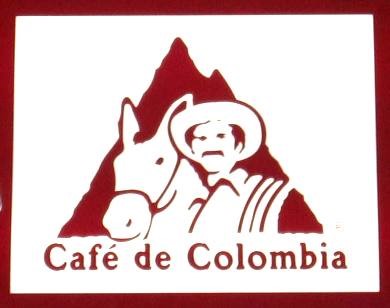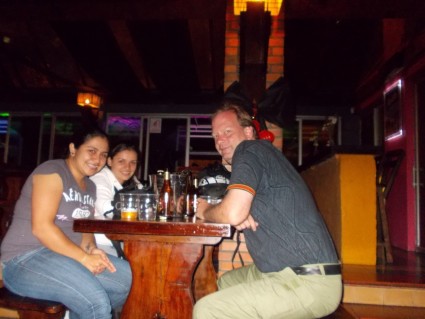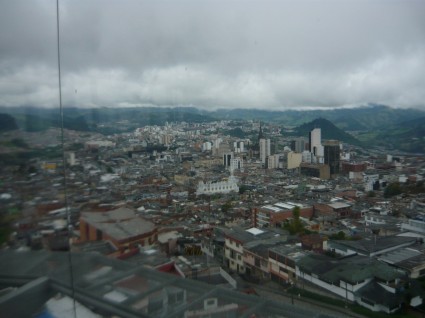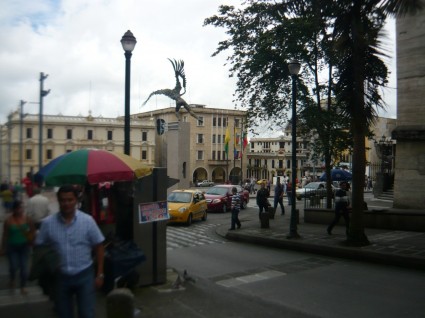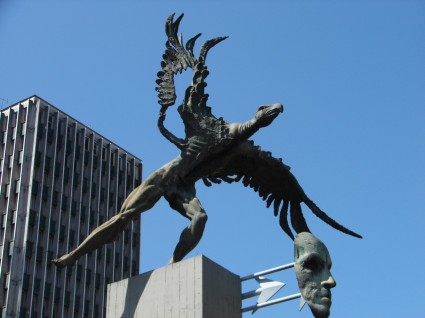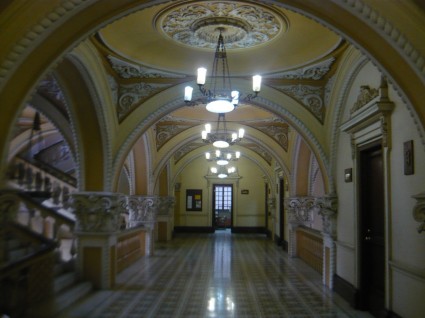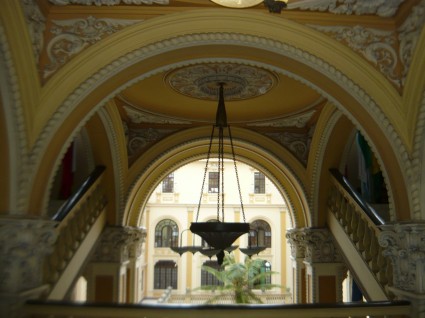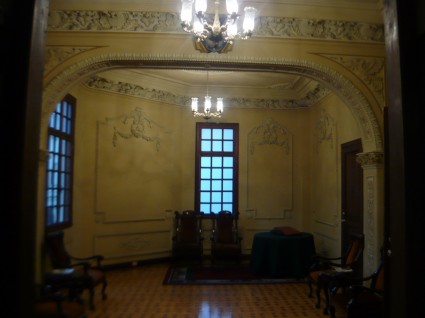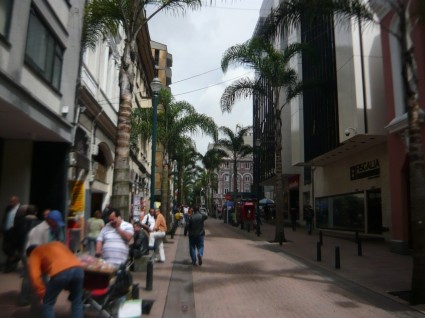December 5, 2013
By: Paul Seymour, Director of Client Services
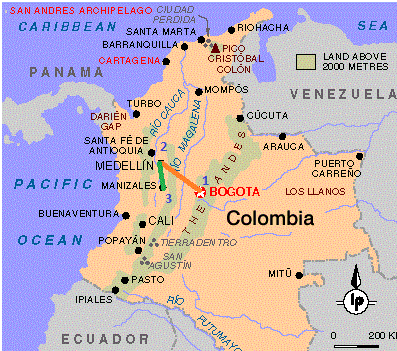
Here I am down in SW Antioquia near the old coffee finca that I used to go to every Saturday in order to pay the caretaker his weekly $60 salary.
In the background, on the left, is Cerro Bravo, at the base of which sits Finca Pa’ Què Màs. It’s a fairly easy climb up an ancient, stone, Indian trail, as this long dormant volcano was some sort of sacred site for them. Over towards the right in the background is the pyramid-shaped Cerro Tusa. Featured on the old Juan Valdez logo:
As you can imagine, it’s a much tougher climb, and a couple of people have slid off into the trees, and never been found.
Not long after I took this photo, the bike started sputtering, and then suddenly died in the middle of nowhere. Fortunately, I happened to know this stretch of nowhere, and even more fortunately, there was a roadhouse right there, and I was only 7 kilometers from the next town. I asked if anyone would take me to town to find a mechanic, and an old guy living there along the river was happy to oblige. We found a young guy who was willing to do what he could, but freely admitted that 650’s were rare in this neck of the woods, and he wasn’t sure if he could do anything or not. So I got on the old guy’s rickety 100, and the kid followed us back to the roadhouse. Without going into too many details, he played around for a while not getting anywhere, and then called another guy in town, to whom he bowed, due to superior mechanical skills. He had already told me though, that he thought it might be the magneto. After three guys, all of whom made the house call from Bolombolo, had played around with it for 2 hours, they finally decided to pull off the cover and look at the magneto. It was completely buggered after one of the screws broke loose and shredded it. The first young guy made me admit to all-present, that he said it first.
Mystery solved, now what to do about it? Medellìn was 2 hours backwards, and the next place to have the part would be 2 hours onwards, and a much smaller place. The old guy who ran me to town and back (I paid him $4 and he was very grateful) said he would put the bike in his house for the night while I went back to Medellìn to buy the part, which would have to be done the following day. They also said that I could load it in an empty truck returning from somewhere to Medellin, and take it with me back to the city. Although they were biased toward the option of leaving it there, and returning with the part for them to replace, they fully understood my hesitancy to leave it there. There’s an old Paisa expression—“I’d loan you my girlfriend before I’d loan you my bike”, so thinking in that vein, I decided to get it on a truck. Exactly 3 seconds after conveying that decision to my new found team, they saw a likely candidate coming up the road, and starting waving and whistling. The truck slammed on the brakes, and they asked if the guy would be willing to take the bike and the Gringo back to Medellìn.
He was riding with another guy, and said he’d be glad to throw it in the back of his van, and even find me a good mechanic and hotel in Itagui (south side of town) for $55. Without ever even having needed a tow in Colombia before, I knew that was a hell of a price considering the spot I was in. He also told me to give his riding companion 5 bucks for a bus back to town so I could ride in comfort. Done again. Then I pulled off the luggage carriers, to the relief of the guys who were gladly going to help me lift it into the back of this truck, as the thought of taking them off never occurred to them….Then about 5 of us lifted it 3-4 feet up into the back of the truck, and they tied it off.
Then was the moment of truth. I bought them all either a soda or beer as they wished, and asked the fateful question—How much do you guys want? They thought about it, and came up with $16. Done, and done in a rapid fashion. Back to Itagui, where the next day the part was a painful $500, as only authentic Suzuki parts would do, whereas in many cases, generic Colombian, or other nationality parts would exist. The labor and 2 quarts of oil were another $26, and I ended up finally starting on Grandma Seymour’s birthday, October 30th, which I accepted as a good omen, despite the accumulated trials and tribulations
This time, I blow on down the road without issues. What a great feeling it was, after not having a bike for a couple of years. Unfortunately, the Pan Am Highway in Antioquia remains a 2-lane affair, twisting through the mountains. The bike blows past the slow trucks with ease, but there are a lot of them, and each one holds me up for a minute or two as I wait for a non-blind corner, and the lack of the proverbial oncoming bus.
I finally arrive in Manizales around rush hour. Manizales sits on the top of a hill, and is San Francisco-ish with its steep, hilly nature, and I don’t know exactly where I’m going, except that it’s called El Cable. The added weight on the back, and constantly being stopped on a steep upgrade, is making me wince at what I’m doing to the poor clutch. I follow a couple of signs, and then get downtown, and not sure of exactly where I am. I pull over and ask a guy on the sidewalk for El Cable, and he starts giving me directions. Keep in mind, that with my helmet on, I’m just another Colombian guy on a bike, even with all the gear on the back. As he’s giving me directions in rush hour traffic at the side of the street, he suddenly gets distracted and points me over to two girls on a scooter, who motion that they will take me there, and for me to follow.
This isn’t uncommon around these parts, and I’m grateful for the help, because the directions were sounding like it was still a ways off through town. So I follow them on their scooter for what seems like an eternity. At one stop light, near El Cable, they say they want to buy me a beer, and tell me to follow them to a parking spot at the mall, which I do. I realize then, that I’m not where I thought I was, but figure it’ll work out okay. We get parked and they lead me to a nice little place, and order a bucket of Club Colombia. I learn that they are living together, are life-long friends, and now in college. One studying architecture, and the other I don’t recall. Then, after reciprocating with another bucket of Clubs, and as I’ve told them about my trip, and that I’m not in the part of town where I meant to be, they lead me to a recommended hostel close by. It’s actually a better area than where I was trying to go in the first place. It’s in the Zona Rosa, Zona Rosa meaning the bar and restaurant district.
Fernanda and Karina. They said they were faced with another boring evening in front of the TV and went out looking for something different, never expecting to meet a Gringo on a continental tour.
I used to scoff at hostels, thinking they were strictly for young, backpacking kids, and only had dormitory style rooms, but I tried them about a year ago while travelling from BOG to MDE, and found out that they all have private rooms as well, and I greatly prefer the international ambiance. I never cease to meet interesting, English-speaking world travellers in these places. There’s a successful business model in Colombia at the moment with foreigners, and locals alike, buying large, older homes in the best parts of town and converting them into hostels. I stayed at the Mountain Hostel http://www.manizaleshostel.com/en in a large, quiet room for $29. I forgot to mention before that these prices are all-in, including the 16% IVA (VAT), and often include a decent breakfast. They also will wash, dry and fold a load of clothes for $5, and with the shared kitchen, I can make my favorite Juan Valdez coffee, in my preferred method, and with real, whole cream in the mornings, and make a fried egg sandwich for breakfast when it’s not already included. As they’ve converted the house’s garage into a restaurant, they also allowed me to park the bike in the restaurant, at no additional charge, with the caveat that I pull it out in the morning. I like flexibility.
So far, I think you can see that people do things here that would not likely happen in Los Angeles or Detroit, nor Berlin or London unless they were looking to harvest your organs. I’ve just grown accustomed to it, and find it normal nowadays, but still greatly appreciate it.
As the hostel also sold beer, we sat on the balcony and had a few more before saying goodnight. During that stint, Fernanda and Karina told me about the sights, and offered to take me to Chipre the following day, as they were on vacation and were planning to go anyway. I needed to catch up on some work, and put that off for another day, and we parted ways.
When I did go to Chipre, it was another slightly unusual experience. It is just a tower on a hill which acts as a look-out point. During my 10 week tour of Europe in 1999, I got in the habit of going to the lookout point at the first opportunity in order to get oriented. Usually an old church bell tower with a few thousand steps, and no elevator. I used a lot of heat rub on that trip. Here’s a photo from Chipre of the small city of Manizales. Elevator, yes.
In the foreground, you can see a narrow steel walkway 6 floors up. After I’d been up there for a couple of minutes the guy who I paid $1 to enter came up and started talking to me, as I was the only person there on this weekday morning. As usual he wanted to know why I lived in Colombia rather than the good ol’ US of A. I, for the 1,000th time, explained that it was a matter of personal freedom, and quality of life. As if to make my point, he then asked me if I was the adventurous sort. I said that I thought I was, and he offered to let me walk around the tower on that small walkway for an additional $5. It looked like a balance beam to me suddenly, and made me tickle in a sensitive region, and I declined, but the point is, would I be able to do that in the US or EU even if I wanted to? I’m sure it would void any legally required insurance policy, and therefore be verboten. He did say that there was a safety cable involved, but I still wasn’t in to it. Must be getting old.
Another day I went walking around the downtown area, and had yet another surprise. Across from the main square there is a very nice looking old building. Here’s a picture of the obligatory Simon Bolivar statue which resides in every main square in seemingly every town of the Republic.
Manizales, however was founded in the late 1850’s, and this Bolivar is half vulture, half naked man, with a vulture’s face, and a human face sculpted at the beast’s feet.
Anyway, you can see the nice old building across from the statue in the 1st photo. I approached it, and saw a security apparatus including the police, so figured I wasn’t going to get in, when the cop waved me around the turnstile. Especially surprising as I was dressed a bit ragged and carrying a beer. Well, you know me, I jumped at the opportunity, and went right on in. Beautiful place, so I started taking photos.
Then some lady came out of a nearby office, and approached me. I thought the gig was up, but she started asking me if I wanted a tour instead. I took a sip, shrugged, and said “sure”. So she went and found someone else to take me around and explain everything. Turns out it was the Governor’s offices for the Province of Caldas. I went through the governor’s and first lady’s offices, and this room was where they met visiting dignitaries, such as the President of the Republic.
At one point we looked out on the square, with the statue across the street, and I asked her what was the significance of the buzzard Bolivar with the human face below? After crinkling her forehead for a moment, she said she thought it represented the 2-faced, scavenging nature of politicians. Nice to have that kind of skepticism at work in the Governor’s office. Too bad they would never allow it up north. Can you imagine the same sculpture of Obama across from the White House?
Then I went down the pedestrian-only street.
I’m always on the lookout for some good food, and I ducked into a place called El Suizo (the Swissman), and was glad I did. According to the history on the menu, it was founded by a Swissman back in the 60’s, and still carries on his traditions and recipes. I got a version of beef Wellington with great puff pastry and gravy, including a salad with great homemade dressing, and the perfect cup of coffee, all for $6. A very nice change of pace.
Finally, I need to comment on the culture and economy/prices. In the neighborhood where the hostel was located, it was obviously upper middle class, with large, well-kept homes. As I said, some have been converted to businesses, but there are zoning laws in Colombia too, and the types of businesses allowed in such an area are somewhat restricted. I did see studio apartments for rent at $250 per month. That, including the generally lower prices for everything, made it obvious that Manizales is not only an apparently very livable city, also included in the Paisa culture (even a bit more friendly), and at 10-20% lower costs.
I don’t sell real estate, but I seem to have an eye for the next good spot. I got into the Hammock, in north Florida, before they built the championship, Oceanside golf course with million-dollar condos, and then the coffee farm in Colombia for peanuts when everyone called me a nut. Contrarian is the right word, and the idea is to buy low and sell high. How do you buy low? Recognize what everyone else will, before they see it. Kind of like getting out of the former America 17 years ago, when all thought I was loon for that, too. I think there’s much more upside potential in Manizales than in now discovered Medellìn. The push going on to sell real estate to foreigners there is in danger of forming a bubble. You heard it here first brethren.
Personally, I would have at least 2 places, and three if I could swing it. One in a city, or just outside one. And at least one other, either on the beach, or a mountain chalet. Preferably all three. They would all be very moderate sized, but well located, and cozy. What I’m getting at, is that I wouldn’t want to live year-round anywhere. Not Medellin, nor Manizales, and certainly not Miami (even for a day, unfortunately). With that said, I could easily pass 2-3 months at a time in a place like Manizales, before getting a cheap flight to my beach shack, maybe down in Ecuador. For what you could sell one large home for in many parts of the US or EU, you could buy 2-3 smaller places in South America, with combined property taxes much lower than your one place ”up there”, and a quality of life much higher, based on my personal definitions of “quality of life”, of course.
If you’d like to start living 3 times better, with real freedom, and for half the cost, the first step is to move your assets out of the US or EU before it’s too late, and you can no longer afford to live in the rapidly developing “third world”. Feel free to contact me anytime at [email protected] to discuss asset protection, or living and investing overseas.
Living well is the best revenge
Hasta la próxima muchachos, y mucha suerte.
Paul, as of 1996, is an escaped former Big 4 CPA (financial statement auditor), and Corporate Controller/CFO who found a natural home in the offshore industry with Bobby Casey and the gang at GWP. Contact him at [email protected] to learn more about the realities of economical offshore asset protection.
An offshore company and bank account can be established for as little as $1,797, including my advice and assistance throughout both processes, and in both privacy-respecting jurisdictions, apostils required to open bank accounts, and courier charges to send original documents to you. There’s never any need to visit the jurisdictions personally, although they’re very nice places, and I recommend a visit. With our established agency agreements, we can do everything via e-mail. We maintain long-term relationships with our clients, and remain available for consultation on an ongoing basis.

